Renewable Energy Pathways toward Accelerating Hydrogen Fuel Production: Evidence from Global Hydrogen Modeling
Abstract
1. Introduction
2. Literature Review
- Nuclear restrictions (restricting the deployment of new nuclear facilities in nations with these policies in place or proposed [41]) and a hydrogen to city gas blend ratio of 5% by volume.
- Equal mitigation obligations for both the Organization for Economic Co-operation and Development (OECD) and the non-OECD nations of 65% carbon dioxide reductions, in order to achieve the same rate of reduction as the current regime which seeks an 80% reduction from OECD, and a 60% reduction from non-OECD nations.
- Nuclear restrictions, as was the case in policy 1, with an increased hydrogen to city gas blend ratio of 30%, the theoretical maximum for the existing infrastructure and utilities [42].
3. Data and Methodology
Statistical Modeling
4. Results and Discussion
5. Conclusions and Policy Implications
Author Contributions
Funding
Informed Consent Statement
Data Availability Statement
Conflicts of Interest
References
- Karmaker, S.C.; Sen, K.K.; Singha, B.; Hosan, S.; Chapman, A.J.; Saha, B.B. The Mediating Effect of Energy Poverty on Child Development: Empirical Evidence from Energy Poor Countries. Energy 2022, 243, 123093. [Google Scholar] [CrossRef]
- Stambouli, A.B.; Khiat, Z.; Flazi, S.; Kitamura, Y. A Review on the Renewable Energy Development in Algeria: Current Perspective, Energy Scenario and Sustainability Issues. Renew. Sustain. Energy Rev. 2012, 16, 4445–4460. [Google Scholar] [CrossRef]
- Razi, F.; Dincer, I. Renewable Energy Development and Hydrogen Economy in MENA Region: A Review. Renew. Sustain. Energy Rev. 2022, 168, 112763. [Google Scholar] [CrossRef]
- Peker, M.; Kocaman, A.S.; Kara, B.Y. Benefits of Transmission Switching and Energy Storage in Power Systems with High Renewable Energy Penetration. Appl. Energy 2018, 228, 1182–1197. [Google Scholar] [CrossRef]
- IEA. IEA World Energy Investment 2019–Analysis–IEA; IEA: Paris, France, 2019. [Google Scholar]
- Ritchie, H.; Roser, M.; Rosado, P. Energy. Available online: https://ourworldindata.org/energy (accessed on 3 October 2022).
- Chapman, A.; Itaoka, K.; Farabi-Asl, H.; Fujii, Y.; Nakahara, M. Societal Penetration of Hydrogen into the Future Energy System: Impacts of Policy, Technology and Carbon Targets. Int. J. Hydrogen Energy 2020, 45, 3883–3898. [Google Scholar] [CrossRef]
- Chapman, A.; Itaoka, K.; Hirose, K.; Davidson, F.T.; Nagasawa, K.; Lloyd, A.C.; Webber, M.E.; Kurban, Z.; Managi, S.; Tamaki, T.; et al. A Review of Four Case Studies Assessing the Potential for Hydrogen Penetration of the Future Energy System. Int. J. Hydrogen Energy 2019, 44, 6371–6382. [Google Scholar] [CrossRef]
- Midilli, A.; Dincer, I. Hydrogen as a Renewable and Sustainable Solution in Reducing Global Fossil Fuel Consumption. Int. J. Hydrogen Energy 2008, 33, 4209–4222. [Google Scholar] [CrossRef]
- Moliner, R.; Lázaro, M.J.; Suelves, I. Analysis of the Strategies for Bridging the Gap towards the Hydrogen Economy. Int. J. Hydrogen Energy 2016, 41, 19500–19508. [Google Scholar] [CrossRef]
- Chapman, A.J.; Fraser, T.; Itaoka, K. Hydrogen Import Pathway Comparison Framework Incorporating Cost and Social Preference: Case Studies from Australia to Japan. Int. J. Energy Res. 2017, 41, 2374–2391. [Google Scholar] [CrossRef]
- Chaube, A.; Chapman, A.; Shigetomi, Y.; Huff, K.; Stubbins, J. The Role of Hydrogen in Achieving Long Term Japanese Energy System Goals. Energies 2020, 13, 4539. [Google Scholar] [CrossRef]
- Zapantis, A.; CCS Institute. Blue Hydrogen Outlook. 2021. Available online: https://www.globalccsinstitute.com/wp-content/uploads/2021/04/Circular-Carbon-Economy-series-Blue-Hydrogen.pdf (accessed on 4 October 2022).
- Haszeldine, R.S.; Flude, S.; Johnson, G.; Scott, V. Negative Emissions Technologies and Carbon Capture and Storage to Achieve the Paris Agreement Commitments. Philos. Trans. R. Soc. A Math. Phys. Eng. Sci. 2018, 376, 20160447. [Google Scholar] [CrossRef] [PubMed]
- Anandarajah, G.; McDowall, W.; Ekins, P. Decarbonising Road Transport with Hydrogen and Electricity: Long Term Global Technology Learning Scenarios. Int. J. Hydrog. Energy 2013, 38, 3419–3432. [Google Scholar] [CrossRef]
- Andrews, J.; Shabani, B. The Role of Hydrogen in a Global Sustainable Energy Strategy. Wiley Interdiscip. Rev. Energy Environ. 2014, 3, 474–489. [Google Scholar] [CrossRef]
- Lazarou, S.; Vita, V.; Diamantaki, M.; Karanikolou-Karra, D.; Fragoyiannis, G.; Makridis, S.; Ekonomou, L. A Simulated Roadmap of Hydrogen Technology Contribution to Climate Change Mitigation Based on Representative Concentration Pathways Considerations. Energy Sci. Eng. 2018, 6, 116–125. [Google Scholar] [CrossRef]
- Bridgeland, R.; Chapman, A.; Mclellan, B.; Sofronis, P.; Fujii, Y. Challenges toward Achieving a Successful Hydrogen Economy in the US: Potential End-Use and Infrastructure Analysis to the Year 2100. Clean. Prod. Lett. 2022, 3, 100012. [Google Scholar] [CrossRef]
- Hai, N.N. Renewable Energy Development in Vietnam. Available online: https://accept.aseanenergy.org/renewable-energy-development-in-vietnam/ (accessed on 22 December 2022).
- Hoang, A.T.; Foley, A.M.; Nižetić, S.; Huang, Z.; Ong, H.C.; Ölçer, A.I.; Pham, V.V.; Nguyen, X.P. Energy-Related Approach for Reduction of CO2 Emissions: A Critical Strategy on the Port-to-Ship Pathway. J. Clean. Prod. 2022, 355, 131772. [Google Scholar] [CrossRef]
- Qiu, Y.; Li, Q.; Wang, T.; Yin, L.; Chen, W.; Liu, H. Optimal Planning of Cross-Regional Hydrogen Energy Storage Systems Considering the Uncertainty. Appl. Energy 2022, 326, 119973. [Google Scholar] [CrossRef]
- Osman, A.I.; Mehta, N.; Elgarahy, A.M.; Hefny, M.; Al-Hinai, A.; Al-Muhtaseb, A.H.; Rooney, D.W. Hydrogen Production, Storage, Utilisation and Environmental Impacts: A Review; Springer International Publishing: Berlin/Heidelberg, Germany, 2022; Volume 20, ISBN 0123456789. [Google Scholar]
- Pang, K.Y.; Liew, P.Y.; Woon, K.S.; Ho, W.S.; Wan Alwi, S.R.; Klemeš, J.J. Multi-Period Multi-Objective Optimisation Model for Multi-Energy Urban-Industrial Symbiosis with Heat, Cooling, Power and Hydrogen Demands. Energy 2023, 262, 125201. [Google Scholar] [CrossRef]
- Way, R.; Ives, M.C.; Mealy, P.; Farmer, J.D. Empirically Grounded Technology Forecasts and the Energy Transition. Joule 2022, 6, 2057–2082. [Google Scholar] [CrossRef]
- Yue, M.; Lambert, H.; Pahon, E.; Roche, R.; Jemei, S.; Hissel, D. Hydrogen Energy Systems: A Critical Review of Technologies, Applications, Trends and Challenges. Renew. Sustain. Energy Rev. 2021, 146, 111180. [Google Scholar] [CrossRef]
- Shibata, Y. Economic Analysis of Hydrogen Production from Variable Renewables. IEEJ Energy J. 2015, 10, 26–46. [Google Scholar]
- Hossain, M.S.; Pandey, A.K.; Tunio, M.A.; Selvaraj, J.A.; Al-Fatlawi, A.W.A.; Hoque, K.E. Statistical Modeling for Hydrogen Production Using Wind Energy. Int. J. Mater. Mech. Manuf. 2015, 4, 218–222. [Google Scholar] [CrossRef]
- Folorunsho, A.T.; Promise, E.U.; Abel, U.A. Bioconversion of Locally Made Cassava Wastewater for Biohydrogen Production and Its Statistical Analysis: A Case of Response Surface Methodology (RSM) and Artificial Neural Network (ANN). Renew. Energy Res. 2016, 1, 1–7. [Google Scholar] [CrossRef]
- Sepehri, S.; Rostami, K.; Azin, M. The Optimization and Statistical Analysis of Fermentative Hydrogen Production Using Taguchi Method. Int. J. Chem. React. Eng. 2020, 18, 20190212. [Google Scholar] [CrossRef]
- Moussa, R.N.; Moussa, N.; Dionisi, D. Hydrogen Production from Biomass and Organic Waste Using Dark Fermentation: An Analysis of Literature Data on the Effect of Operating Parameters on Process Performance. Processes 2022, 10, 156. [Google Scholar] [CrossRef]
- Hermesmann, M.; Müller, T.E. Green, Turquoise, Blue, or Grey? Environmentally Friendly Hydrogen Production in Transforming Energy Systems. Prog. Energy Combust. Sci. 2022, 90, 100996. [Google Scholar] [CrossRef]
- George, J.F.; Müller, V.P.; Winkler, J.; Ragwitz, M. Is Blue Hydrogen a Bridging Technology?––The Limits of a CO2 Price and the Role of State-Induced Price Components for Green Hydrogen Production in Germany. Energy Policy 2022, 167, 113072. [Google Scholar] [CrossRef]
- Domínguez, S.; Cifuentes, B.; Bustamante, F.; Cantillo, N.M.; Barraza-Botet, C.L.; Cobo, M. On the Potential of Blue Hydrogen Production in Colombia: A Fossil Resource-Based Assessment for Low-Emission Hydrogen. Sustainability 2022, 14, 11436. [Google Scholar] [CrossRef]
- Nadaleti, W.C.; de Souza, E.G.; Lourenço, V.A. Green Hydrogen-Based Pathways and Alternatives: Towards the Renewable Energy Transition in South America’s Regions–Part B. Int. J. Hydrogen Energy 2022, 47, 1–15. [Google Scholar] [CrossRef]
- Barhoumi, E.M.; Okonkwo, P.C.; Ben Belgacem, I.; Zghaibeh, M.; Tlili, I. Optimal Sizing of Photovoltaic Systems Based Green Hydrogen Refueling Stations Case Study Oman. Int. J. Hydrogen Energy 2022, 47, 31964–31973. [Google Scholar] [CrossRef]
- Oni, A.O.; Anaya, K.; Giwa, T.; Di Lullo, G.; Kumar, A. Comparative Assessment of Blue Hydrogen from Steam Methane Reforming, Autothermal Reforming, and Natural Gas Decomposition Technologies for Natural Gas-Producing Regions. Energy Convers. Manag. 2022, 254, 115245. [Google Scholar] [CrossRef]
- Hoang, A.T.; Huang, Z.H.; Nižetić, S.; Pandey, A.; Nguyen, X.P.; Luque, R.; Ong, H.C.; Said, Z.; Le, T.H.; Pham, V.V. Characteristics of Hydrogen Production from Steam Gasification of Plant-Originated Lignocellulosic Biomass and Its Prospects in Vietnam. Int. J. Hydrogen Energy 2022, 47, 4394–4425. [Google Scholar] [CrossRef]
- Hoang, A.T.; Nižetić, S.; Olcer, A.I.; Ong, H.C.; Chen, W.H.; Chong, C.T.; Thomas, S.; Bandh, S.A.; Nguyen, X.P. Impacts of COVID-19 Pandemic on the Global Energy System and the Shift Progress to Renewable Energy: Opportunities, Challenges, and Policy Implications. Energy Policy 2021, 154, 112322. [Google Scholar] [CrossRef] [PubMed]
- Taipabu, M.I.; Viswanathan, K.; Wu, W.; Hattu, N.; Atabani, A.E. A Critical Review of the Hydrogen Production from Biomass-Based Feedstocks: Challenge, Solution, and Future Prospect. Process Saf. Environ. Prot. 2022, 164, 384–407. [Google Scholar] [CrossRef]
- Ishaq, H.; Dincer, I.; Crawford, C. A Review on Hydrogen Production and Utilization: Challenges and Opportunities. Int. J. Hydrogen Energy 2022, 47, 26238–26264. [Google Scholar] [CrossRef]
- World Nuclear Association Country Profiles. Available online: https://www.world-nuclear.org/information-library/country-profiles/others/european-union.aspx (accessed on 4 October 2022).
- Jones, D.R.; Al-Masry, W.A.; Dunnill, C.W. Hydrogen-Enriched Natural Gas as a Domestic Fuel: An Analysis Based on Flash-Back and Blow-off Limits for Domestic Natural Gas Appliances within the UK. Sustain. Energy Fuels 2018, 2, 710–723. [Google Scholar] [CrossRef]
- Hosoya, Y.; Fujii, Y. Analysis of Energy Strategies to Halve CO2 Emissions by the Year 2050 with a Regionally Disaggregated World Energy Model. Energy Procedia 2011, 4, 5853–5860. [Google Scholar] [CrossRef]
- Fujii, Y.; Komiyama, R. Long-Term Energy and Environmental Strategies. In Reflections on the Fukushima Daiichi Nuclear Accident: Toward Social-Scientific Literacy and Engineering Resilience; Springer: Cham, Switzerland, 2015; pp. 21–50. ISBN 9783319120904. [Google Scholar]
- Komiyama, R.; Fujii, Y. Analysis of Energy Saving and Environmental Characteristics of Electric Vehicles in Regionally Disaggregated World Energy Model. Electr. Eng. Japan (Engl. Transl. Denki Gakkai Ronbunshi) 2014, 186, 20–36. [Google Scholar] [CrossRef]
- IPCC. Climate Chane 2014: Synthesis Report; IPCC: Geneva, Switzerland, 2014; Volume 218.
- Höhne, N.; den Elzen, M.; Weiss, M. Common but Differentiated Convergence (CDC): A New Conceptual Approach to Long-Term Climate Policy. Clim. Policy 2006, 6, 181–199. [Google Scholar] [CrossRef]
- Bell, A.; Jones, K. Explaining Fixed Effects: Random Effects Modeling of Time-Series Cross-Sectional and Panel Data. Polit. Sci. Res. Methods 2015, 3, 133–153. [Google Scholar] [CrossRef]
- de Miranda, P.E.V. Hydrogen Energy: Sustainable and Perennial. In Science and Engineering of Hydrogen-Based Energy Technologies: Hydrogen Production and Practical Applications in Energy Generation; de Miranda, P.E.V., Ed.; Academic Press: Cambridge, MA, USA, 2018; pp. 1–38. ISBN 978-0-12-814251-6. [Google Scholar]
- International Energy Agency. The Future of Hydrogen: Seizing Today’s Opportunities; International Energy Agency: Paris, France, 2019; Volume 203.

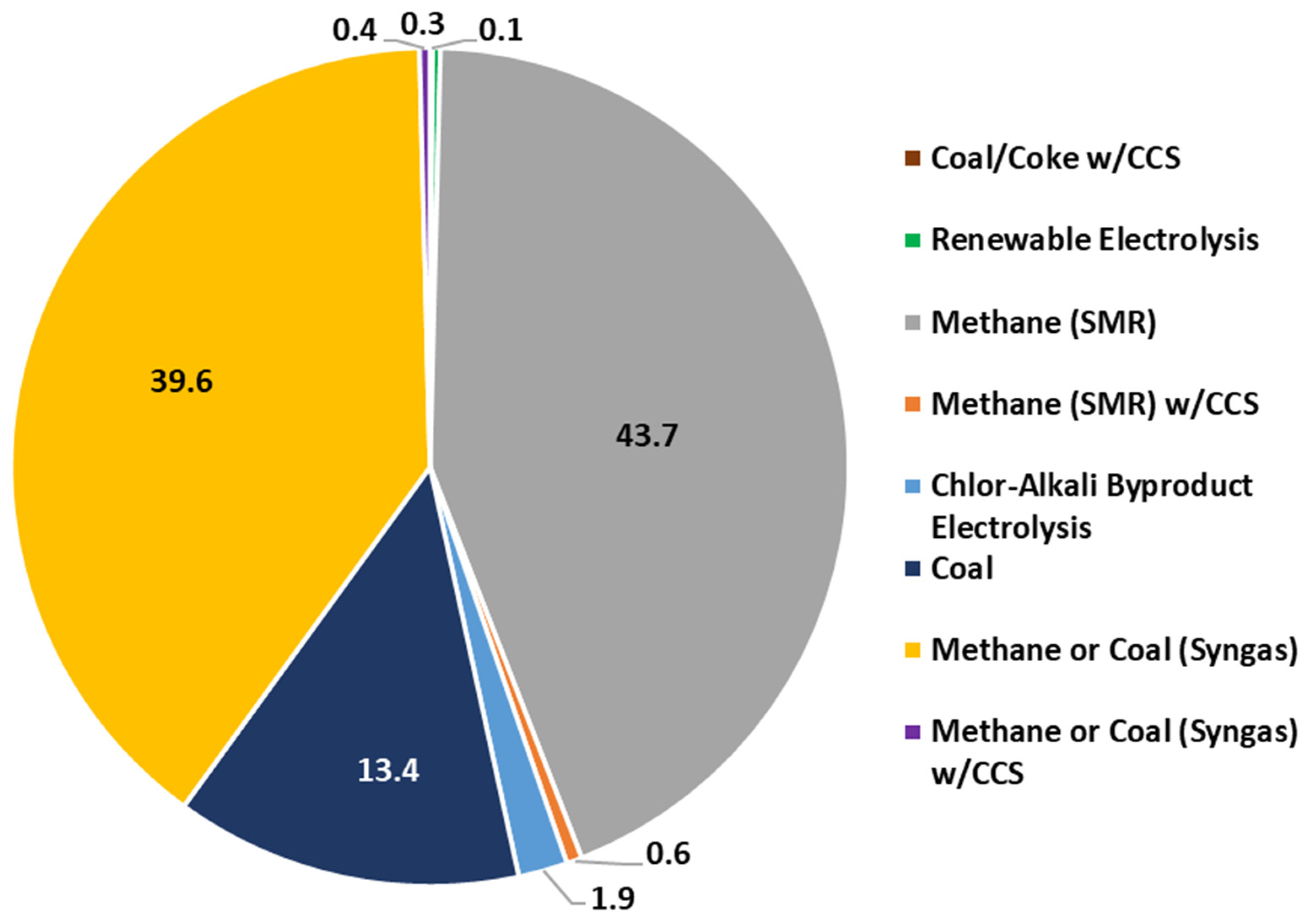
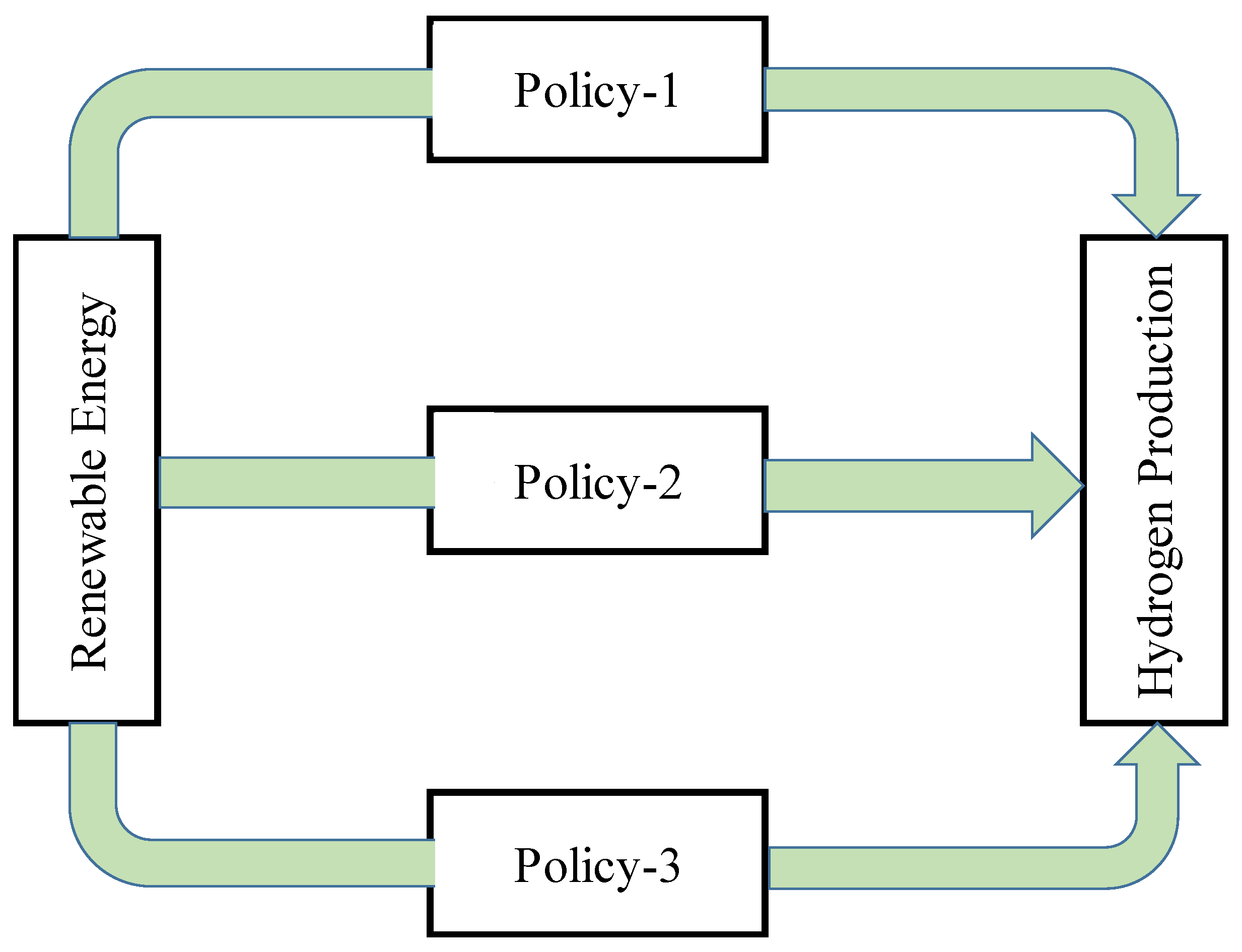
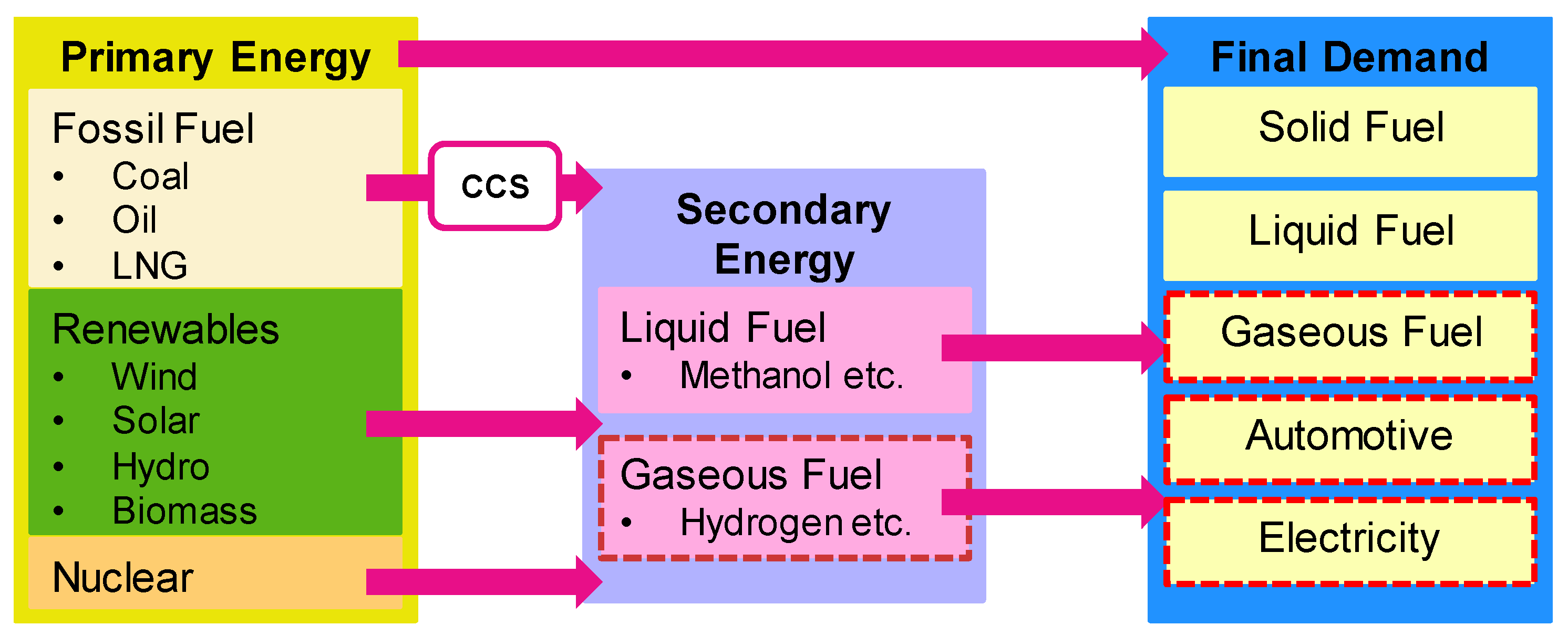
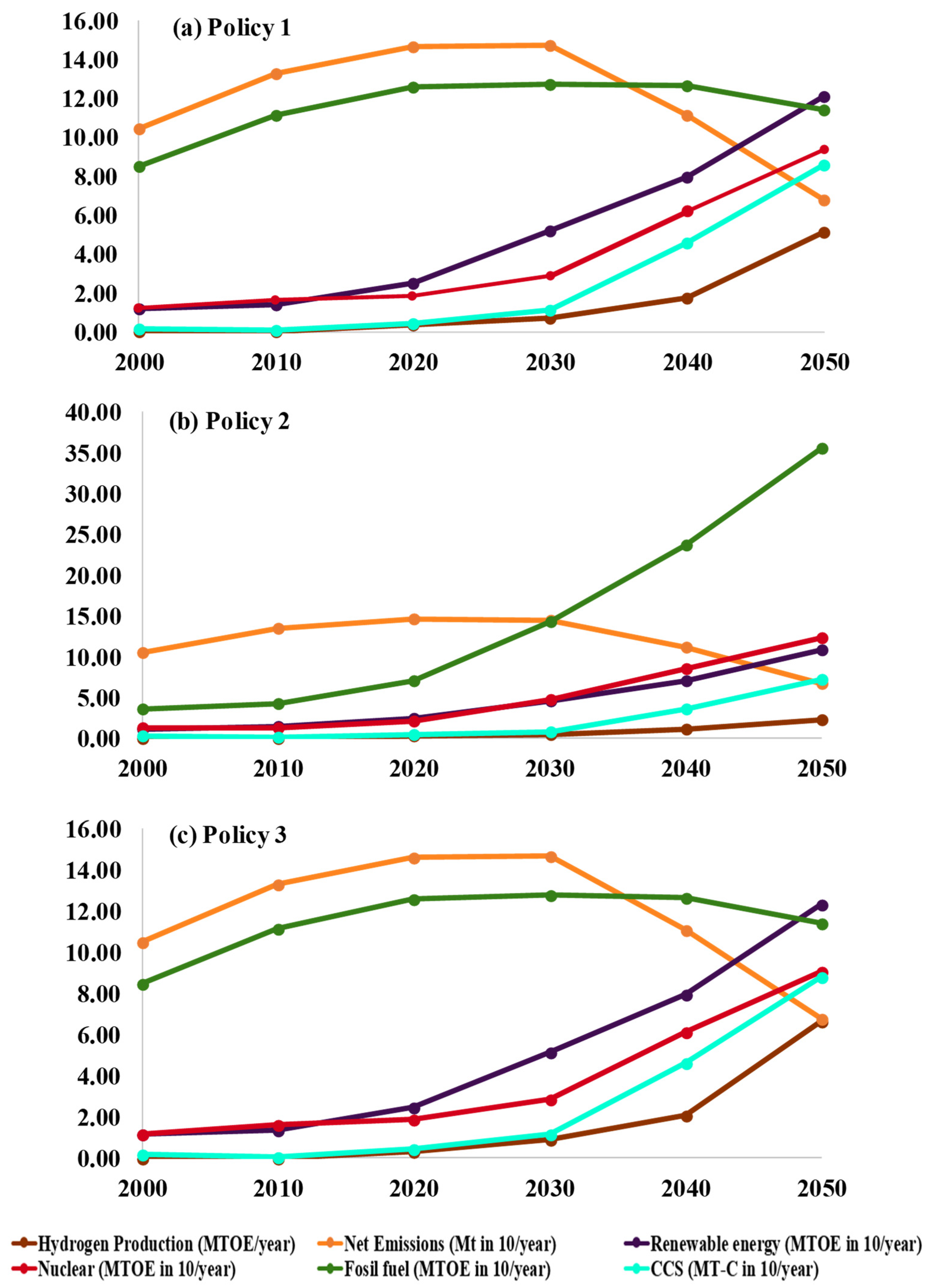
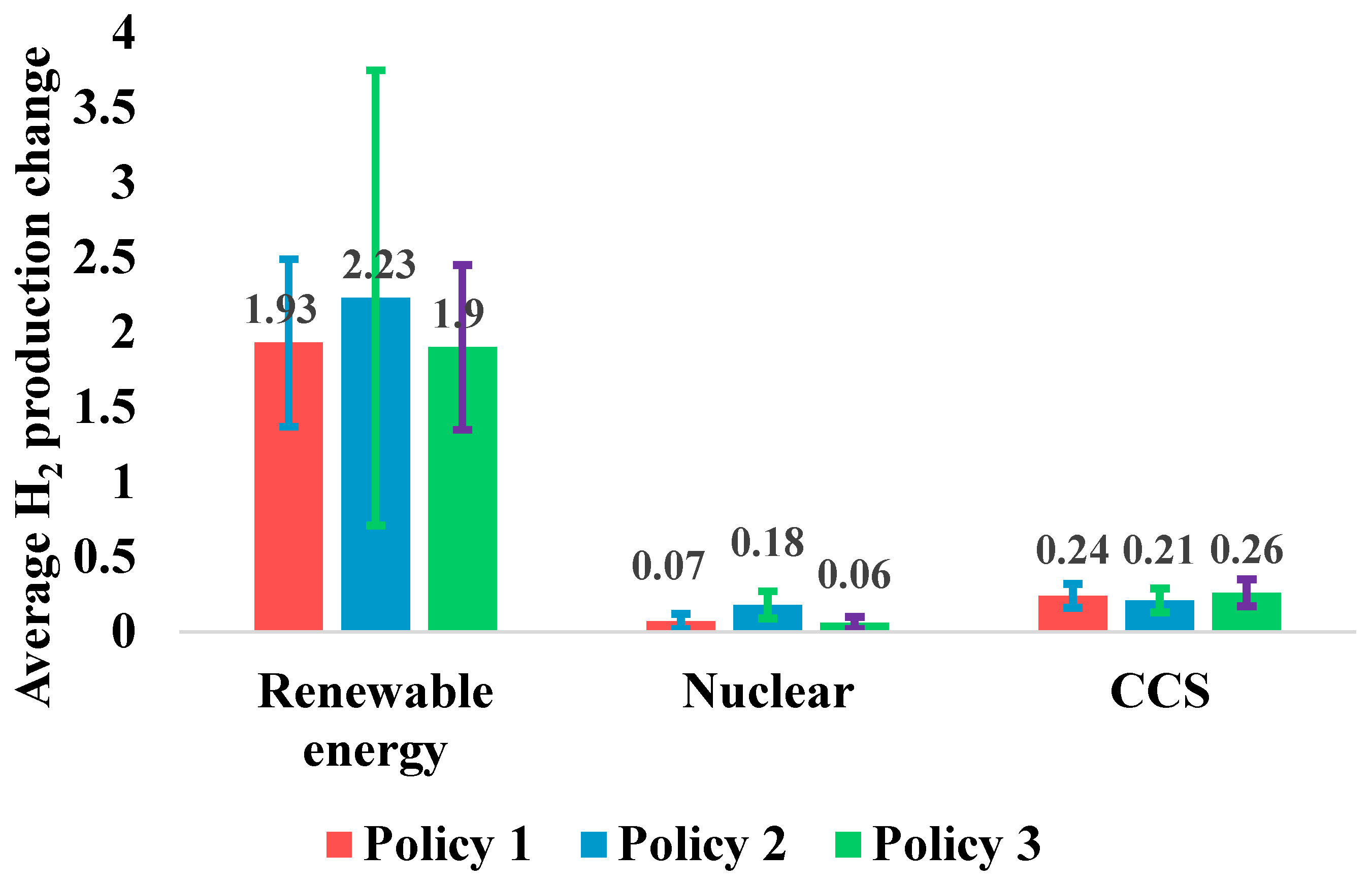
| Policy Scenario | Variable | Estimates | p-Value | 95% Confidence Interval | |
|---|---|---|---|---|---|
| Policy 1 (Nuclear restriction and 5% city gas blending) | ln(renewable) | 1.929 | 0.000 | 1.369 | 2.489 |
| ln(nuclear) | 0.067 | 0.008 | 0.018 | 0.116 | |
| ln(fossil) | −0.010 | 0.836 | −0.108 | 0.087 | |
| ln(ccs) | 0.243 | 0.000 | 0.161 | 0.325 | |
| Policy 2 (Equal mitigation obligation) | ln(renewable) | 2.225 | 0.004 | 0.696 | 3.753 |
| ln(nuclear) | 0.177 | 0.000 | 0.087 | 0.267 | |
| ln(fossil) | −0.795 | 0.342 | −2.438 | 0.847 | |
| ln(ccs) | 0.2086 | 0.000 | 0.126 | 0.291 | |
| Policy 3 (Nuclear restriction and 30% city gas blending) | ln(renewable) | 1.901 | 0.000 | 1.343 | 2.458 |
| ln(nuclear) | 0.063 | 0.006 | 0.018 | 0.107 | |
| ln(fossil) | −0.012 | 0.800 | −0.102 | 0.079 | |
| ln(ccs) | 0.255 | 0.000 | 0.173 | 0.337 | |
Disclaimer/Publisher’s Note: The statements, opinions and data contained in all publications are solely those of the individual author(s) and contributor(s) and not of MDPI and/or the editor(s). MDPI and/or the editor(s) disclaim responsibility for any injury to people or property resulting from any ideas, methods, instructions or products referred to in the content. |
© 2022 by the authors. Licensee MDPI, Basel, Switzerland. This article is an open access article distributed under the terms and conditions of the Creative Commons Attribution (CC BY) license (https://creativecommons.org/licenses/by/4.0/).
Share and Cite
Karmaker, S.C.; Chapman, A.; Sen, K.K.; Hosan, S.; Saha, B.B. Renewable Energy Pathways toward Accelerating Hydrogen Fuel Production: Evidence from Global Hydrogen Modeling. Sustainability 2023, 15, 588. https://doi.org/10.3390/su15010588
Karmaker SC, Chapman A, Sen KK, Hosan S, Saha BB. Renewable Energy Pathways toward Accelerating Hydrogen Fuel Production: Evidence from Global Hydrogen Modeling. Sustainability. 2023; 15(1):588. https://doi.org/10.3390/su15010588
Chicago/Turabian StyleKarmaker, Shamal Chandra, Andrew Chapman, Kanchan Kumar Sen, Shahadat Hosan, and Bidyut Baran Saha. 2023. "Renewable Energy Pathways toward Accelerating Hydrogen Fuel Production: Evidence from Global Hydrogen Modeling" Sustainability 15, no. 1: 588. https://doi.org/10.3390/su15010588
APA StyleKarmaker, S. C., Chapman, A., Sen, K. K., Hosan, S., & Saha, B. B. (2023). Renewable Energy Pathways toward Accelerating Hydrogen Fuel Production: Evidence from Global Hydrogen Modeling. Sustainability, 15(1), 588. https://doi.org/10.3390/su15010588






